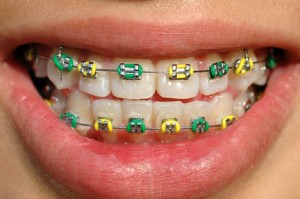It’s spring! That means the start of a new sports season. It also means it’s once again time to remind our patients at Horner Barrow Orthodontics to protect their faces, and their precious smiles while out on the field playing sports. According to the National Youth Sports Safety Foundation, young children, middle school and high-school athletes and adults have more than 5,000,000 teeth knocked out in sporting events annually. That’s a LOT of displaced teeth.
If you are going to be participating in any spring sports, it’s very important to have a properly fitting mouthguard as part of your essential equipment. Mouthguards can prevent cracked, chipped or broken teeth, lip and cheek injuries, jawbone fractures, mouth lacerations, and sometimes, even concussions.
Just remember, the only way a mouthguard will work is if you actually wear it, during practice and during a game! Wearing a mouthguard can make the difference between losing your teeth or not. One thing for our patients who play high school sports to keep in mind is this: your mouthguard from last year may no longer fit as it should because your jawbone is still growing and changing. Dr. Kevin Horner, Dr. Keri Barrow, and our team at Horner Barrow Orthodontics would be happy to fit you for a new mouthguard.
To learn more about mouthguards, or for any other questions you may have about your orthodontic treatment, please give us a call at our Sioux Falls, SD office!
Child Orthodontics
An apple a day for good oral health!
 If you want to maintain and/or improve your children’s oral and dental health, there are plenty of ways to do that with smart, healthy food selections, rather than the obvious avoidance of sugary foods and drinks like candy and soda. Did you know that apples are a healthy food for teeth?
If you want to maintain and/or improve your children’s oral and dental health, there are plenty of ways to do that with smart, healthy food selections, rather than the obvious avoidance of sugary foods and drinks like candy and soda. Did you know that apples are a healthy food for teeth?
An Apple A Day
Of course, we all know that apples are an all-around healthy food, so it shouldn’t come as a surprise that they’re good for your teeth, too. Apples are slightly acidic, which means they act as a gentle cleaning agent for your teeth. Although they’re certainly not a replacement for regular brushing and flossing, apples can also help to whiten your smile when eaten, as long as you eat the skin, too.
Yes, even if your child is wearing braces or Invisalign®, they can still eat apples to help improve their smile, but will have to use more care in doing so. Don’t allow them to bite into the whole apple with braces on – instead, cut up (and if they’re old enough, teach them how to cut up) the apple into smaller, bite-sized slices or pieces. This will help to maintain the integrity of the brackets, and ensure they don’t have to have anything readjusted, and it saves you a trip to the orthodontist, as well!
Having braces or Invisalign® should not keep your child from eating healthy foods – in fact, choosing foods with an eye for good oral and dental health is even more important!
The staff at Horner Barrow Orthodontics will be happy to help you and your children figure out the best way to make their smiles be as bright and healthy as possible. Call us at our Sioux Falls, SD office today to schedule your appointment with Dr. Kevin Horner or Dr. Keri Barrow!
Your Braces Rubber Band Color…What It Says About You
Even if you’re not all that happy about having to wear braces, selecting the color of your rubber bands is sure to make you smile. Whether you want to coordinate your braces with your latest outfits, express your inner creative side, or show some serious school spirit, “decorating” your mouth with colorful rubber bands can take away some of the self-consciousness of wearing braces and replace that with some fun!
What do your rubber band color choices say about you? Check out this rubber band “horoscope.”
Red. You’re intense and forward-thinking. You don’t back down no matter how big the challenge that’s presented to you. Red is also the color of the heart, so red rubber bands indicate you’re a considerate, caring, loving person.
Orange. Orange may indicate you’re an artist or a drama student. You’re fearless, daring and wild, a little flamboyant and lots of fun. You have a big personality, and you’re not concerned what other people think about you. On the flip side, orange is also the color of balance and energy. And being flamboyant and fun definitely takes a lot of energy!
Green. A green traffic light means go, right? So you’re a person who’s always on the move. Go, go, go! Nothing slows you down. It also means you’re generous, compassionate and kind. Green is the color of nature and spring, so it says you love our planet. Maybe you’re passionate about recycling. Green is also the color of good luck…think four-leaf clover!
Blue. You’re relaxed – cool as a cucumber. Nothing gets you upset. You stay calm, even when your mom says you can’t chew gum or eat popcorn because of your braces.
Purple. Purple says you’re the creative type, without a doubt. You march to the beat of a different drum, and you tend to think outside the box. It says you’re mysterious. Purple is also the color of royalty, and when you’re wearing your purple rubber bands, you are royally, creatively cool.
Color Combinations
With so many color options, it can be hard to pick just one color. Well, you don’t have to choose! You can decorate your teeth with several colors. Pick the colors of your school, your favorite sports team or go with holiday colors like red and green. If you’re still having a hard time deciding which colors to choose, ask Dr. Horner or Dr. Barrow or one of the Horner Barrow Orthodontics team. We can let you know all of the trends our patients here in Sioux Falls, SD are sporting!
It’s Almost Spring…Time For Your New Beautiful Smile!
 Goodbye winter! Spring is just around the corner. We’re all ready for that wonderful seasonal change from cold, blustery, dreary days to blue skies, blooming flowers, singing birds, and warmer weather. This spring could also be the start of a straighter, healthier, more beautiful smile for you!
Goodbye winter! Spring is just around the corner. We’re all ready for that wonderful seasonal change from cold, blustery, dreary days to blue skies, blooming flowers, singing birds, and warmer weather. This spring could also be the start of a straighter, healthier, more beautiful smile for you!
Have you ever thought about how your mouth would benefit from orthodontic treatment? With spring just days away, we here at Horner Barrow Orthodontics hope that you’ll see the new season as a fresh start for your dental health!
Some Fun Ways To Count Down Your Time In Braces
Wearing braces can straighten your teeth, giving you a more attractive smile for life. The entire process can take 18 months to two years (or more). This can seem like a very LONG time away when you first get your braces put on. Counting down your time in braces can help you pass that time more quickly, and build the excitement for that day when you finally get your braces removed.
Create a Calendar
Crossing off each day on a calendar is a common way of counting down the days. You can make this more personal by designing your own calendar to help you count down. Use one of the many online customization services to upload photos or designs for each month of your calendar. Each month’s picture could also show the number of months remaining until you expect to have your braces taken off.
Plan Rewards For Yourself
When you receive regular rewards for continuing to wear your braces, they can seem less bothersome. Plan to give yourself a reward every month that you wear your braces for the duration of the treatment. The time will pass much more quickly when you are earning rewards for your patience.
Make a Fun Paper Chain
Use strips of colorful paper to create the links of your chain, and add a new link each week to lengthen the chain. Before sealing each new strip of paper into a circle, write a reason on the paper strip of why you are getting your teeth straightened, or an event in the future when you will appreciate your straight teeth as you smile, such as having your senior pictures taken.
Make a Simple Wall Hanging
Purchase a large pad of blank white paper. Write a “0” on the bottom sheet and a “1” on the next, and continue until you reach the number of days remaining for your orthodontic treatment. Tear off the top sheet each day to see how many days are left and remind yourself of the progress you are making.
Find a Braces Buddy
If any of your friends get braces around the same time as you, share the experience. Make a pact to celebrate each trip to our Sioux Falls, SD office when one of you receives news about your progress.
Having braces doesn’t have to be a tedious, boring process. Have some fun with it…you’ll be glad you did. At Horner Barrow Orthodontics, we’re happy that you’ve chosen us to help you create your new, beautiful smile for life!
What is a water pik? Do I need one?
Water piks (also known as oral irrigators) are a great addition to your regular oral health care routine of brushing and flossing. An especially helpful tool for those folks who suffer from periodontal disease (gingivitis) and for our patients in orthodontic treatment with full braces, water piks use tiny, but powerful bursts of water to dislodge bits of food, bacteria, and other yucky debris hiding in the nooks and crannies of your mouth. Patients in orthodontic treatment may find using a water pik helpful if their toothbrush bristles tend to get caught on the wires or brackets.
When you use a water pik, you’re not only dislodging any particles or debris and bacteria you might have missed when brushing, you are also gently massaging your gums, which helps promote blood flow in the gums, keeping them healthy. Do keep in mind, however, that while water piks are an excellent addition to your daily fight against gingivitis and other periodontal diseases, they are NOT capable of completely removing plaque. That’s why Dr. Horner and Dr. Barrow and the team at Horner Barrow Orthodontics want to remind you to keep brushing and flossing every day, and to continue to see your family dentist every six months for your regular dental checkups.
If you have sensitive teeth or gums and find it uncomfortable to floss daily, a water pik can be a good way to reduce discomfort while effectively cleaning between teeth. Diabetics sometimes prefer water piks to flossing because they don’t cause bleeding of the gums, which can be a problem when using floss. If you have a permanent bridge, crowns, or other type of dental restoration, you may also find that using a water pik helps you keep the area around the restorations clean.
How do you choose the right water pik for you?
Water piks are available for home or portable use. The home models are larger and use standard electrical outlets, while the portable versions use batteries. Aside from the size difference, they work in essentially the same way, both using pulsating water streams. A more critical difference in water piks is the ability to adjust the water pressure. Most home models will let you choose from several pressure settings, which can be very important, depending on how sensitive your teeth and gums are. Most portable versions have only one pressure setting. If you want to use mouthwash or a dental rinse in your water pik, first check the label. Some water piks recommend using water only.
Please give us a call at our Sioux Falls, SD office if you have any questions about water piks. You can also ask Dr. Horner or Dr. Barrow about them during your next visit.
Summer Vacation Braces Care Tips
Summer is (finally) here, and that means family fun, vacations, adventures and great memories are just around the corner!
At Horner Barrow Orthodontics, we know our patients want to have a sparkling, radiant white smile. Here are a few easy tips for you to remember to help you keep your smile healthy and beautiful not just this summer, but all year long!
Try to avoid drinks that will stain your teeth like coffee, soft drinks, or dark-colored fruit juices. Not only will drinks such as these soften your tooth enamel, but they will also darken that fabulous smile you’re working on!
Another tip is to continue to focus on brushing your teeth. Sometimes, when busy schedules start filling up, taking the time to brush your teeth really well tends to be less of a priority. A good tip for keeping your mouth safe from the staining we mentioned above, and from other possible pitfalls, is to rinse your mouth with water after any meal when you aren’t able to fully brush your teeth. It sounds like such a simple thing, but your teeth, inside and out, will benefit!
We encourage you and your parents to be more conscious of any possible plans coming up when making your summer appointments with us. If you are planning on taking a vacation this summer, we ask that you let us know ahead of time so that we can schedule your summer appointments around your time away.
If you will be gone for an extended amount of time (six weeks or more), we recommend that you visit our office prior to leaving and schedule another appointment shortly after you return home.
One last important tip. Please remember not to eat any hard, sticky, or chewy treats while enjoying your vacation.
And remember, whether you are headed to a cookout or picnic, a camping trip, amusement park, or just having fun in your own backyard this summer, we want to hear about it. We look forward to seeing you soon and hearing about all your summer adventures!
DOES MY CHILD NEED BRACES OR ORTHODONTIC TREATMENT?
This is a popular question we get asked by parents who are considering orthodontic treatment for their child. The question of whether or not your child should get braces really depends on a few things.
- If your child is age 7 or older, have they had their first orthodontic evaluation by an orthodontic specialist? If not, you should schedule this initial examination with an orthodontist.
- Has your dentist recommended an orthodontic evaluation for your child?
- Did you, your spouse, or another one of your children require braces?
- Do you have a concern with your child’s smile or bite (jaw alignment)?
If you answered yes to any of these last three questions, you can probably guess that again, the recommendation would be to schedule a consultation with an orthodontic specialist. An orthodontic specialist is a dentist who has received 2–3 years of additional training (beyond dental school) learning the proper way to straighten and align teeth and jaws. Your specialist will be able to provide a treatment recommendation and review answers to your question “Should my child get braces?”
If your child is a candidate for orthodontic treatment, your orthodontist can recommend the best time to start treatment. As a general rule of thumb, the American Association of Orthodontists recommends evaluation no later than age 7 by an orthodontic specialist. Although the majority of our early patient visits result in observation only, at no cost to the patient, this is the first time your orthodontist will be able to predict future jaw growth and potential problems.
Why age 7? It’s when your child will finally have enough permanent teeth in their mouth (6-year molars, and some, if not most or all, of their front permanent incisors). Before this time, it’s difficult to determine where your child’s future jaw alignment is headed; and rightly so, as prior to this age your child has predominantly baby teeth (teeth that are going to fall out).
Of course, in today’s economic times, we understand that there can be a concern as to the financial aspects of orthodontic treatment. That is why we’ve put together a great offer designed specifically for you! Just click the banner below our post and you’ll receive a FREE orthodontic exam and x-ray evaluation.
EARLY ORTHODONTICS (BRACES) MAY MEAN LESS TREATMENT LATER
Look at yearbook or prom pictures from the 1970s or ’80s and you’ll see lots of smiles sporting heavy metal braces. It’s a sight that’s less common in high schools today. That’s because children today tend to get braces at a much earlier age. Some patients with special problems begin orthodontic treatment at age 7 or younger.
“The American Association of Orthodontics (AAO) recommends that all children receive an orthodontic screening by age 7,” says Dr. Horner. “Permanent teeth typically begin to emerge at age 6 or 7. It is at this point that orthodontic problems become apparent.
“Because bones are still growing, it’s an ideal time to evaluate a child,” Dr. Horner says. “Then we can determine what orthodontic intervention, if any, may be needed either now or in the future.”
Braces Can Be Fun
To make braces more acceptable and fun for young people, manufacturers have made brightly colored elastic bands. These are the small rubber bands that hold the wires to the braces. Children can choose elastics with their school colors or a holiday color scheme, such as orange and black for Halloween.
Choosing the color of the elastics allows patients to personalize their braces, making them more fun and stylish.
Getting Used To Braces
Braces today are less uncomfortable and less visible than they used to be. But they still take some getting used to. Food can get caught around brackets and in wires, and flossing and brushing can take more time. Sometimes the teeth may be a little sore, after an adjustment. Tooth discomfort can be alleviated with the use of a pain reliever, such as ibuprofen (Advil, Tylenol and others) or aspirin. The use of lighter and more flexible wires has greatly lessened the amount of soreness or discomfort during orthodontic treatment.
As more and more children get braces, nicknames such as “tin grin” and “metal mouth” are heard less often. Because treatment has become more socially acceptable, embarrassment may be less of a concern.
Braces (And More)
Orthodontic treatment in young children is known as interceptive orthodontics. Intervention may begin as early as age 6 or 7. At this age, the teeth are still developing. The jaw is still growing. That means certain conditions, such as crowding, may be easier to address.
Before permanent teeth come in, it may be possible to help teeth to erupt (emerge through the gums) into better positions. It’s common, for example, for the dental arch to be too small to fit all of the teeth. A few decades ago, the solution for crowding was almost always to extract some of the permanent teeth to make space. Then fixed braces were used to position the teeth properly.
Early intervention takes advantage of the fact that a child’s jaw is still growing. For example, a device called a palatal expander may be used to expand the child’s upper dental arch. Once the arch is the proper size, there’s a better chance that the adult teeth will emerge in better position. Sometimes teeth still may be crowded after all of them have erupted. In such cases, some permanent teeth may still have to be extracted to make room to properly align the teeth.
Early treatment also may be beneficial when the dental arches and jaws are not in the correct position. Functional appliances may fix or improve these problems. More treatment usually is needed later on, but it may be shorter and less involved.
It is important to note that early treatment does not apply to all orthodontic problems. However, it may help in certain cases.
Two conditions that require early intervention are crossbites and protruding front teeth. A crossbite can cause the jaws to grow unevenly. Front teeth that stick out may be fractured or injured in an accident, such as a fall.
“One thing to be aware of is that children who receive interceptive orthodontics generally still need braces or other orthodontic appliances later,” Dr. Horner says. “However, this early treatment may help shorten, and simplify, future treatment in some cases.” This is commonly known as two-phase treatment.
HOW TO CHOOSE THE BEST ORTHODONTIST FOR YOU AND YOUR CHILD
Choosing an orthodontist is an important decision, but it does not have to be an overwhelming task. Look for an orthodontic specialist who is well-recommended, board certified, has a gallery of completed cases available for you to view, and one who is flexible and understands that your schedule is busy, too.
Word of mouth recommendations are usually the best way to start out a search for a new medical provider of any kind. Orthodontists know this, and good ones will make sure they cultivate relationships with patients and referring dentists.
“Horner Barrow Orthodontics enjoys a great reputation with referring dentists; but, the families of our patients have been one of our best referral sources,” says Dr. Kevin Horner.
Today, many general dentists have taken classes to offer braces or clear aligners (Invisalign®), but an orthodontist is still the best choice for orthodontic procedures.
General dentists are experts in diagnosis of dental decay, preventative dentistry and restoring, replacing and repairing teeth, while an orthodontist is an expert in the diagnosis, prevention and treatment of dental and facial irregularities.
Orthodontists have two to three years of additional specialized orthodontics education accredited by the American Dental Association, and the best orthodontists are also board certified.
After finding a highly-recommended orthodontic office, look at samples of their finished work and find out if the office is a good fit. Many practices have a gallery of smiles on their website, but the office will also have photos on display of patients who have completed treatment.
Call the office to get the basic information, find out if appointments are open for new patients, discuss insurance and financing policies and ask if they offer free consultations. That is the ideal time to discuss treatment goals and how much experience the orthodontist has in correcting specific problems.
“Our staff at both offices are more than happy to answer any questions potential patients have about our practice,” says Dr. Horner.
Orthodontic treatment can be a lengthy process, and patients interact with the doctors on a nearly monthly basis, so make sure the orthodontic practice you choose is one you are comfortable with and confident about.
There are many, many details that go into selecting an orthodontic practice. Look closely at the details. Ask yourself:
• Who addresses the details for you both professionally and in support service?
• What is the atmosphere you sense when visiting the office?
• Were you treated the way you would choose to be treated?
• Did you walk away understanding the process?
We are very confident about what you will discover at Horner Barrow Orthodontics, and we encourage you to find out for yourself.



